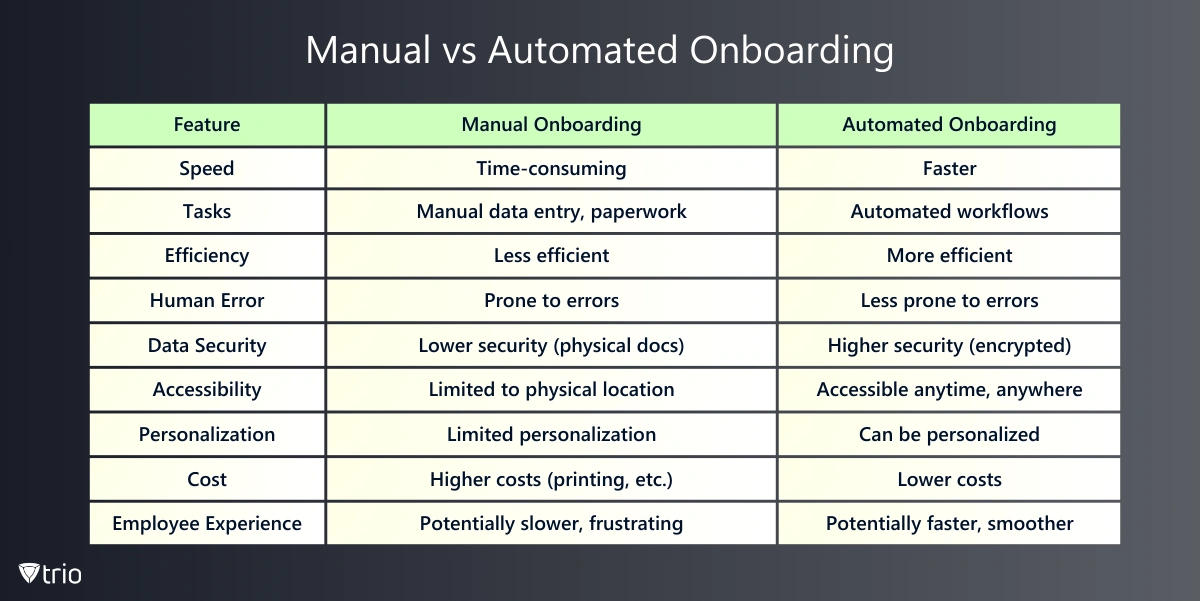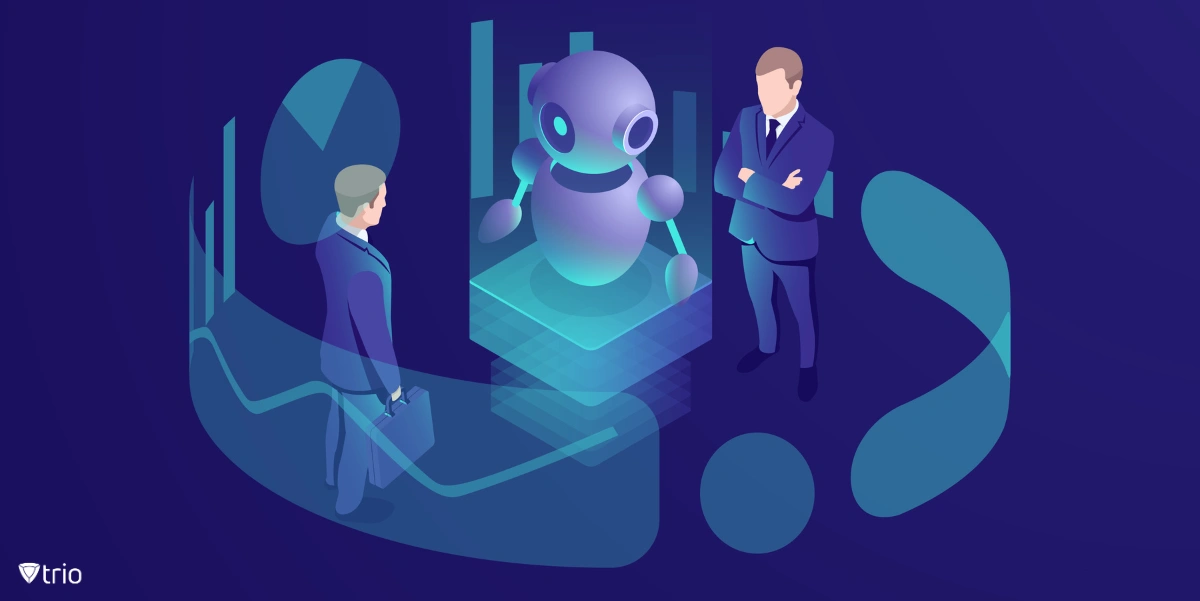In the business landscape, onboarding processes stand as a crucial stage for both employees and customers, serving as the gateway to integration and success. As businesses strive for efficiency and effectiveness, the adoption of onboarding automation emerges as a helpful solution. By using technology to streamline tasks and enhance experiences, automation not only ensures a seamless onboarding journey but also frees up resources for strategic initiatives. In this blog, we’ll delve into the benefits of automating onboarding, how to automate onboarding processes, and how your business can create a great onboarding experience.
What is Onboarding Automation?
Manual vs Automated Onboarding Comparison
Deciding between manual and automated onboarding depends on your specific business needs. Here’s a breakdown of some key factors to consider:
For smaller businesses with a simple onboarding process, manual onboarding might be sufficient. However, as your company grows and the onboarding process becomes more complex, with multiple steps and departments involved, automation can significantly improve efficiency and reduce errors.
Budget is another important factor. Manual onboarding has lower upfront costs, but ongoing expenses like printing and HR time can add up. Automated onboarding requires an initial investment in software, but can save money in the long run, especially with a larger workforce.
The type of roles you’re hiring for also plays a role. Roles requiring extensive training or specialized knowledge might still benefit from a more manual approach. However, for many positions, automated onboarding can handle most of the initial steps, freeing up your HR department for more strategic tasks.
Finally, consider your company culture. Businesses that prioritize personal connection during onboarding might prefer a more manual approach. But don’t dismiss automation entirely! It can streamline administrative tasks like paperwork and data entry, allowing HR to focus on building relationships with new hires during key onboarding stages.
In many cases, the best approach might be a hybrid model that leverages automation for efficiency while allowing for personalized interaction where needed. This can create a smoother onboarding experience for new hires while still fostering a strong company culture.

Why You Should Implement Employee Onboarding Automation: 7 Benefits
Next, we’re going to explore the top seven onboarding automation benefits to help in your decision-making process.
- Efficiency and Time Savings: Automation streamlines the onboarding process, and saves time spent on manual tasks such as paperwork, data entry, and repetitive administrative work. This allows employees and customers to start engaging with products or services more quickly.
- Consistency and Compliance: Automated onboarding ensures that every new employee or customer receives the same level of information and completes required tasks consistently. It also helps organizations adhere to regulatory compliance standards by standardizing processes and documentation.
- Enhanced Scalability: As businesses grow, manual onboarding processes can become overwhelming. Automation allows organizations to scale their onboarding efforts efficiently without significantly increasing resources, enabling seamless expansion and accommodating higher volumes of new hires or customers.
- Improved Engagement and Experience: Automated onboarding can be personalized and tailored to individual needs, leading to a more engaging and positive experience for employees and customers. Customized onboarding experiences can foster stronger connections with the organization from the outset.
- Insights and Analytics: Automation provides valuable data and analytics on the onboarding process, allowing organizations to track key metrics such as completion rates, time to proficiency, and user satisfaction. These insights help identify areas for improvement and optimize the onboarding experience over time.
- Cost Reduction: By automating repetitive tasks and eliminating manual errors, organizations can reduce operational costs associated with onboarding processes. This includes savings on personnel hours, printing, and paperwork expenses, as well as potential fines or penalties from compliance breaches.
- Focus on Strategic Initiatives: With routine onboarding tasks automated, HR teams can allocate more time and resources to strategic initiatives such as talent development, customer retention, and improving overall employee or customer experience, driving long-term business growth and success.
How to Automate Customer Onboarding
To automate customer onboarding effectively, consider following these steps:
Mapping the Customer Journey
Begin by mapping out the customer onboarding journey from the initial interaction to full engagement with your product or service. Identify key touchpoints, milestones, and interactions that customers experience during onboarding, such as account creation, product tutorials, and customer support interactions. By understanding the entire journey, you can identify opportunities to automate processes and streamline the onboarding experience.
Selecting and Implementing Automation Tools
Once the customer journey is mapped out, select and implement automation tools that align with your onboarding objectives and processes. Look for customer relationship management (CRM) systems, marketing automation platforms, or customer onboarding software that offer features such as automated emails, self-service portals, and personalized onboarding workflows. Consider factors such as scalability, integration capabilities, and ease of use when choosing automation tools that will support your onboarding efforts.
Ensuring a Seamless User Experience
To ensure a seamless user experience during customer onboarding, focus on personalization, simplicity, and accessibility. Customize automated communication and onboarding workflows to address each customer’s specific needs, preferences, and pain points. Design self-service portals and user interfaces that are intuitive and easy to navigate, allowing customers to onboard themselves at their own pace. Provide clear instructions, resources, and support channels to guide customers through the onboarding process and address any questions or concerns they may have. By prioritizing a seamless user experience, you can increase customer satisfaction and retention rates while reducing churn.

How to Automate Employee Onboarding Processes
Are you wondering how to automate your employee onboarding processes? Consider the following steps:
Mapping the Employee Journey
Leveraging Technology and Software Solutions
Once the employee journey is mapped out, leverage technology and software solutions to automate various aspects of the onboarding process. Invest in an integrated HR management system or employee onboarding software that can centralize onboarding tasks, automate workflows, and facilitate communication between stakeholders. Look for features such as electronic document signing, task assignment, progress tracking, and onboarding portals that provide new hires with easy access to resources and information.
Customizing Processes for Organizational Needs

Conclusion
This is where automation comes in. By implementing employee onboarding automation with a solution like Trio’s MDM solution, you can significantly improve onboarding efficiency, ensure consistency, and free up valuable HR resources. Trio’s comprehensive MDM platform offers a practical set of features designed to streamline every aspect of onboarding, from device provisioning to deployment.
Try Trio today to see how we can revolutionize your employee onboarding process.




